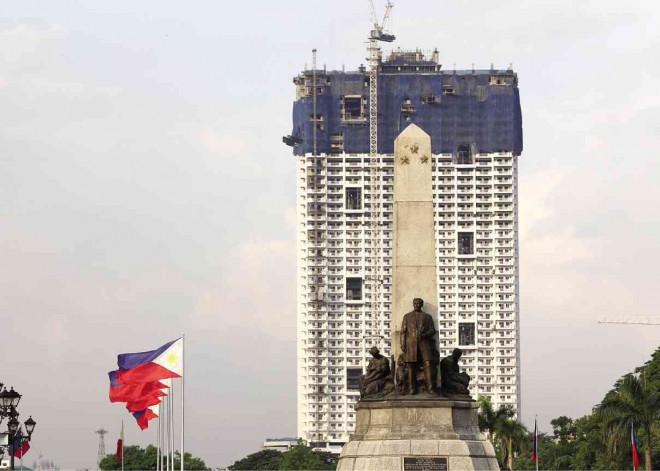Torre de Manila case sparks Estrada-Lim blame game
As work on the controversial Torre de Manila ground to a halt, the blame game between Manila Mayor Joseph Estrada and his predecessor Alfredo Lim began.
Estrada threw the first punch on Thursday by saying that the city government was planning to sue Lim for awarding permits to DMCI Homes Inc., the developer of the 49-story condominium on Taft Avenue which, according to critics, mars the Rizal monument’s line of sight.
In a press conference, Estrada called Lim a “liar” and a “forgetful old man” as he sought to deflect the criticism the city government has been getting over the project.
“We are planning to go after him [Lim]. We are still studying what to do,” he said.
According to Estrada, work on the condominium building would not have started if Lim’s officials did not approve permits or at least scrutinize them.
Article continues after this advertisement“He wants us to undergo a lie detector test. I think he has Alzheimer’s disease. It’s clear that his planning officer and building officials signed the zoning and building permits, respectively, in 2012 during his term,” he added.
Article continues after this advertisementEstrada pointed out that Lim had vetoed a city ordinance that would have limited the height of the condominium. Ordinance 8310 authored by Councilor DJ Bagatsing prohibits structures that mar the line of sight or backdrops of any historical or cultural site or monument, or “diminish [their] dominance and dignity or aesthetically desecrate [their] frontal or natural perspective.”
“But [Lim] vetoed it. He said it was ultra vires which means the council does not have the power to enact such [an] ordinance. He vetoed it while the council was on recess so they [councilors] could not override it. Then he goes on to blame us for this issue,” Estrada said.
The ordinance was vetoed on April 12, 2013, just a month before the national and local elections and while the city’s councilors were busy with their own campaigns.
Estrada, however, refused to comment on the Knights of Rizal (KoR) petition seeking the demolition of Torre de Manila, saying it was up to the Supreme Court.
“We have no choice but to follow what will be the court’s final decision. But to tell you frankly, I want to see construction continue and for it to eventually open because it will help Manila in terms of revenues and jobs,” he said.
On Tuesday, the high tribunal ordered work on Torre de Manila temporarily halted based on the KoR petition.
Lim, meanwhile, threw the blame back at Estrada, as his chief of staff, Ric de Guzman, questioned the incumbent mayor’s motive in allowing the project to continue.
“Two resolutions were passed by the city council—in November and December 2013—to suspend the permit [given to] Torre de Manila. At least a couple of similar resolutions were also passed but … they still allowed [the project] to push through. What do you think happened?” De Guzman said in a statement.
He was referring to the January 2014 resolution issued by the city council ratifying the exemption granted by the Manila Zoning Board of Adjustments and Appeal to DMCI for the Torre de Manila project. Aside from lifting the height limit on the proposed condominium, it also affirmed the validity of the permits given to DMCI during Lim’s administration.
De Guzman also noted that National Historical Commission of the Philippines (NHCP) chair Ma. Serena Diokno did not object to the construction of Torre de Manila in a letter on Nov. 2012. According to Diokno, the building was situated outside the boundaries and buffer zones of Rizal Park and would not obstruct the front view of the monument.
“We gave them all the permits because DMCI complied with all requirements during that time and was even cleared by the NHCP to proceed [with the project]. When we left [office], they [incumbent officials] suspended the permits [given to DMCI] before affirming their validity and giving them an exemption. We leave it to the public to judge what happened here,” De Guzman said.
